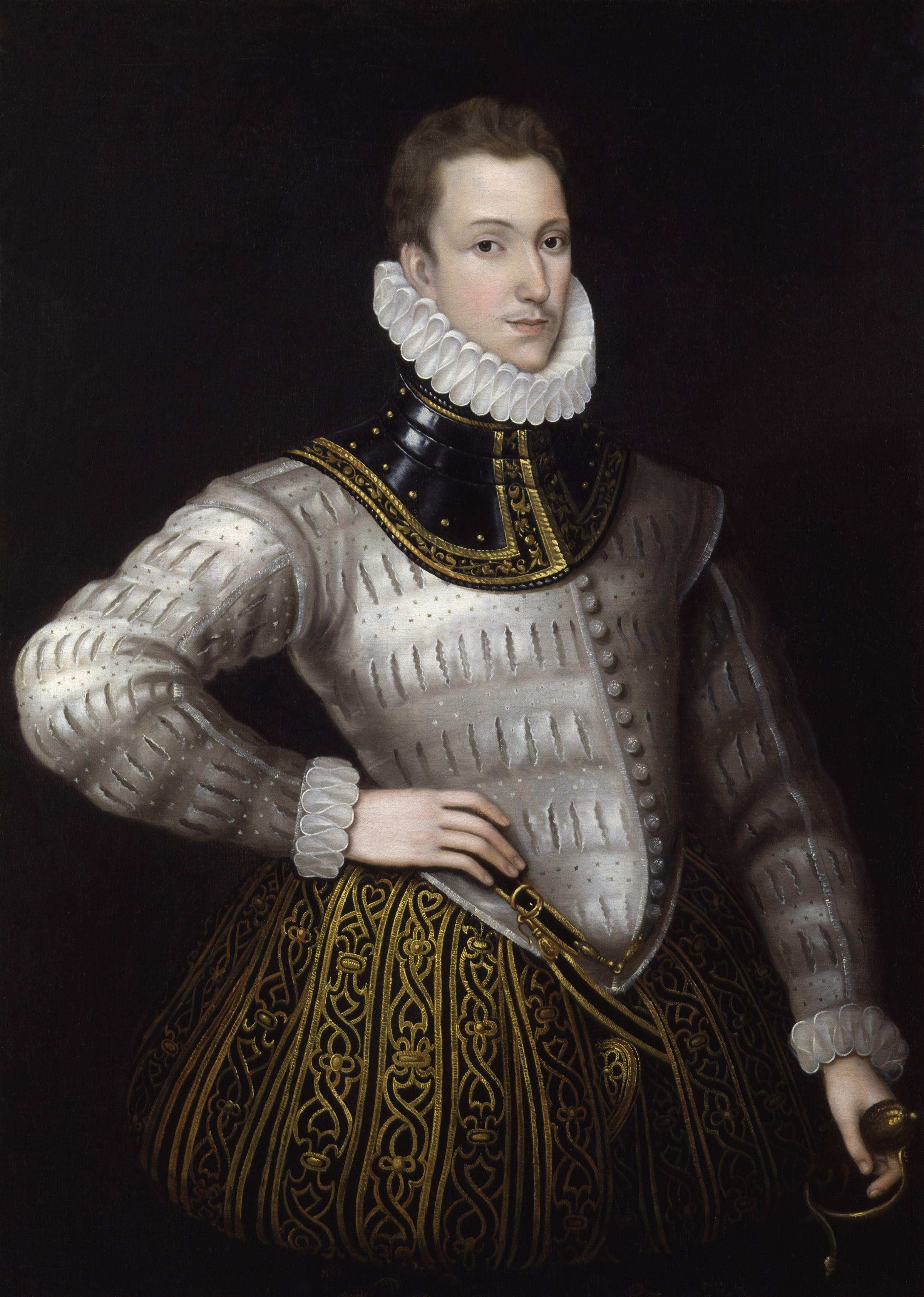
Philip Sidney
Sir Philip Sidney (30 November 1554 – 17 October 1586) was an English poet, courtier, scholar and soldier who is remembered as one of the most prominent figures of the Elizabethan age. His works include a sonnet sequence, Astrophel and Stella, a treatise, The Defence of Poesy (also known as The Defence of Poesie or An Apology for Poetrie) and a pastoral romance, The Countess of Pembroke's Arcadia.
For other people named Philip Sidney, see Philip Sidney (disambiguation).
Philip Sidney
30 November 1554
Penshurst Place, Kent, England
17 October 1586 (aged 31)
Zutphen, Netherlands
Sidney
- English Renaissance
- Petrarchism
Early life[edit]
Born at Penshurst Place, Kent, of an aristocratic family, he was educated at Shrewsbury School and Christ Church, Oxford. He was the eldest son of Sir Henry Sidney and Lady Mary Dudley. His mother was the eldest daughter of John Dudley, 1st Duke of Northumberland, and the sister of Robert Dudley, 1st Earl of Leicester. His sister, Mary, was a writer, translator and literary patron, and married Henry Herbert, 2nd Earl of Pembroke. Sidney dedicated his longest work, the Arcadia, to her. After her brother's death, Mary reworked the Arcadia, which became known as The Countess of Pembroke's Arcadia. His brother, Robert Sidney was a statesman and patron of the arts, and was created Earl of Leicester in 1618.
Literary writings[edit]
Like the best of the Elizabethans, Sidney was successful in more than one branch of literature, but none of his work was published during his lifetime. However, it circulated in manuscript. His finest achievement was a sequence of 108 love sonnets. These owe much to Petrarch and Pierre de Ronsard in tone and style, and place Sidney as the greatest Elizabethan sonneteer after Shakespeare. Written to his mistress, Lady Penelope Rich, though dedicated to his wife, they reveal true lyric emotion couched in a language delicately archaic. In form Sidney usually adopts the Petrarchan octave (ABBAABBA), with variations in the sestet that include the English final couplet. His artistic contacts were more peaceful and significant for his lasting fame. During his absence from court, he wrote Astrophel and Stella (1591) and the first draft of The Arcadia and The Defence of Poesy. His pastoral romance The Arcadia (1598) is an intricate love story, embodying the ideals of the medieval chivalry, so congenial to Sidney's own spirit. The story is diffused and involved, and the many secondary love stories interwoven with the main one distract attention. The characters are vague and idealized. The style, in its strength and its weaknesses, is that of a poet writing prose; melodious, picturesque, rather artificial and ornamental. The story contains a number of fine lyrics. Somewhat earlier, he had met Edmund Spenser, who dedicated The Shepheardes Calender to him. Other literary contacts included membership, along with his friends and fellow poets Fulke Greville, Edward Dyer, Edmund Spenser and Gabriel Harvey, of the (possibly fictitious) "Areopagus", a humanist endeavour to classicise English verse.
Military activity[edit]
Sidney played a brilliant part in the military/literary/courtly life common to the young nobles of the time. Both his family heritage and his personal experience (he was in Walsingham's house in Paris during the Saint Bartholomew's Day Massacre), confirmed him as a keenly militant Protestant.
In the 1570s, he persuaded John Casimir to consider proposals for a united Protestant effort against the Catholic Church and Spain. In the winter of 1575-76 he fought in Ireland while his father was Lord Deputy there.[2] In the early 1580s, he argued fruitlessly for an assault on Spain itself. Promoted General of Horse in 1583,[2] his enthusiasm for the Protestant struggle was given free rein when he was appointed governor of Flushing in the Netherlands in 1585. Whilst in the Netherlands, he consistently urged boldness on his superior, his uncle the Earl of Leicester. He carried out a successful raid on Spanish forces near Axel in July 1586.
In popular culture[edit]
A memorial, erected in 1986 at the location in Zutphen where he was mortally wounded by the Spanish, can be found at the entrance of a footpath (" 't Gallee") located in front of the petrol station at the Warnsveldseweg 170.
In Arnhem, in front of the house in the Bakkerstraat 68, an inscription on the ground reads: "IN THIS HOUSE DIED ON THE 17 OCTOBER 1586 * SIR PHILIP SIDNEY * ENGLISH POET, DIPLOMAT AND SOLDIER, FROM HIS WOUNDS SUFFERED AT THE BATTLE OF ZUTPHEN. HE GAVE HIS LIFE FOR OUR FREEDOM". The inscription was unveiled on 17 October 2011, exactly 425 years after his death, in the presence of Philip Sidney, 2nd Viscount De L'Isle, a descendant of the brother of Philip Sidney.
The city of Sidney, Ohio, in the United States and a street in Zutphen, Netherlands, have been named after Sir Philip. A statue of him can be found in the park at the Coehoornsingel where, in the harsh winter of 1795, English and Hanoverian soldiers were buried who had died while retreating from advancing French troops.[13]
Another statue of Sidney, by Arthur George Walker, forms the centrepiece of the Old Salopians Memorial at Shrewsbury School to alumni who died serving in World War I (unveiled 1924).[14]
Philip Sidney appears as a young man in Elizabeth Goudge's third novel, Towers in the Mist (Duckworth, 1937), visiting Oxford around the time Queen Elizabeth also visited Oxford. (Goudge admitted to slightly advancing the time of Sidney's arrival in Oxford, for the sake of her larger story.)
In the Monty Python's Flying Circus sketches "Tudor Jobs Agency", "Pornographic Bookshop" and "Elizabethan Pornography Smugglers" (Season 3, episode 10), Superintendent Gaskell, a vice squad policeman, is transported back to the Elizabethan age and assumes Sir Philip Sidney's identity.[15][16]
An epitaph of Sir Philip Sidney:
"England has his body, for she it fed;
Netherlands his blood, in her defence shed;
The Heavens have his soul,
The Arts have his fame,
The soldier his grief,
The world his good name."[17]
Works
Books
Articles
Other